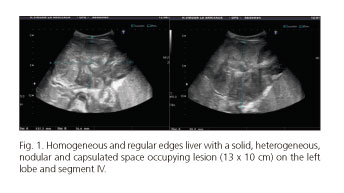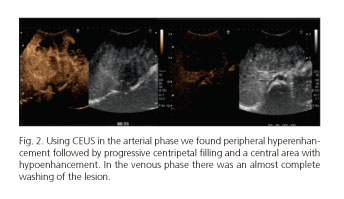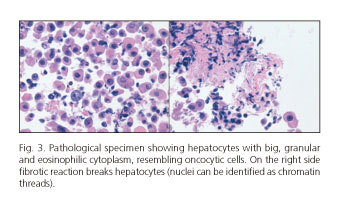My SciELO
Services on Demand
Journal
Article
Indicators
-
 Cited by SciELO
Cited by SciELO -
 Access statistics
Access statistics
Related links
-
 Cited by Google
Cited by Google -
 Similars in
SciELO
Similars in
SciELO -
 Similars in Google
Similars in Google
Share
Revista Española de Enfermedades Digestivas
Print version ISSN 1130-0108
Rev. esp. enferm. dig. vol.108 n.8 Madrid Aug. 2016
PICTURES IN DIGESTIVE PATHOLOGY
Fibrolamellar hepatocellular carcinoma: a rare entity diagnosed by abdominal ultrasound
Carcinoma hepatocelular fibrolamelar, una entidad infrecuente diagnosticada por ecografía abdominal
Esther Estrella-Díez1, Francisco Javier Álvarez-Higueras1, Gema Marín-Zafra3, Águeda Bas2, María Carmen Garre-Sánchez1, Juan Egea-Valenzuela1, Daniel José Nova-López4, Elena Navarro-Noguera1, Gonzalo Antón-Ródenas1 and Luis Fernando Carballo-Álvarez1
1 Digestive Diseases Service, 2 Pathology Service, 3 Medical Oncology Service and
4 Emergency Department. Hospital Clínico Universitario Virgen de la Arrixaca. El Palmar, Murcia. Spain
Case report
We present the case of a 16-year-old male with no previous medical history. He was referred from another hospital because of 4 kg weight loss, jaundice and upper right abdominal pain. He presented mildly elevated liver enzymes, negative hepatotropic viruses and normal levels of alpha-fetoprotein. A thoraco-abdominal computed tomography had been made in his reference hospital finding multiple nodular lesions in both lungs and a hepatic mass (14 x 10 cm). The patient was sent to us for diagnostic ultrasound-guided puncture.
In our study we found a solid, heterogeneous and encapsulated hepatic mass (13 x 10 cm). The lesion was mainly isoechogenic with hyperechogenic areas, located on left liver lobe and segment 4 (Fig. 1), and there were no signs of chronic hepatopathy or portal or biliary permeability alterations. Using contrast enhanced ultrasonography we found peripheral hyperenhacement during arterial phase with progressive wash-out beginning at 2 minutes and 30 seconds (Fig. 2). The study was therefore suggestive of a solitary liver mass with malignant behavior: fibrolamellar hepatocellular carcinoma (FLHC) vs mesenchymal tumor (sarcoma). Fine needle puncture aspiration was made and immunophenotypic (Hep-par-1, CK7, Glypican-3 and CD68) and cytomorphologic findings were compatible with FLHC (Fig. 3). The patient was sent to the oncologist and is under oxaliplatin, folinate calcium and 5-fluorouracil.
Discussion
FLHC is a histologic type of hepatocellular carcinoma that represents only 1% of all the primary liver tumors, with an incidence of 0.02 cases/100,000 individuals (1). This tumor is caused by DNAJB1-PRKACA mutation on chromosome number 9, with deletion in 8 genes: the most frequent are MUC4, associated to other gastrointestinal tumors, and GOLCA6L2 (2). The most commonly affected population is individuals under 40 years (65-85%) with no previous history of hepatopathy (3). Up to 70% of the cases are diagnosed in advanced stages (4) as symptoms are unspecific (abdominal pain 21-74%), levels of alpha-fetoprotein are normal and no signs of hepatopathy are present (1). Differential diagnosis must be done with nodular focal hyperplasia, hemangioma and classic hepatocellular carcinoma. First-choice treatment is surgical resection (1,5).
References
1. Herman P, Lopes Chagas A, Vinicius M, et al. Surgical treatment of fibrolamellar hepatocellular carcinoma: An underestimated malignant tumor? Hepatobiliariy Pancreat Dis Int 2014;13:618-21. DOI: 10.1016/S1499-3872(14)60294-0. [ Links ]
2. Darcy DG, Chiaroni-Clarke R, Murphy JM, et al. The genomic landscape of fibrolamellar hepatocellular carcinoma: Whole genome sequencing of ten patients. Oncotarget 2015;6(2):755-70. [ Links ]
3. Eggert T, McGlynn KA, Duffy A, et al. Fibrolamellar hepatocellular carcinoma in the USA, 2000-2010: A detailed report on frequency, treatment and outcome based on the surveillance, epidemiology, and end results database. United European Gastroenterology Journal 2013;1(5):351-7. DOI: 10.1177/2050640613501507. [ Links ]
4. Njei B, Rajesh Konjeti V, Ditah I. Prognosis of patients with fibrolamellar hepatocellular carcinoma versus conventional hepatocellular carcinoma: A systematic review and meta-analysis. Gastrointestinal Cancer Reserch 2014;7:49-54. DOI: 10.1097/MCG.0000000000000070. [ Links ]
5. Martínez Isla A, Ferrara A, Badía JM, et al. Hepatocarcinoma fibrolamelar. Resultados de la resección hepática parcial. Rev Esp Enferm Dig 1997;89:699-702. [ Links ]











 text in
text in 




